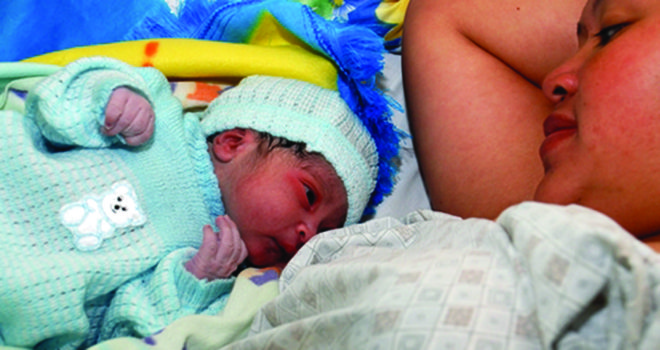
By Kristen Macklingam
The task of addressing the maternal mortality rate in Guyana continues to pose great challenges for the relevant authorities, and despite progress made over the years, instances of mothers dying after childbirth are still too many.
This is according to Chief Medical Officer (CMO) Dr Shamdeo Persaud, who, during an exclusive interview with Guyana Times International last Friday, explained that there are a number of contributing factors which had led to maternal deaths, and the Public Health Ministry is aggressively trying to address them.
“That’s a very difficult task, bearing in mind the magnitude of the problem here in Guyana. First of all, pregnancies will occur wherever people are; so you can imagine (this means) all across Guyana. It is a large country (with) not so large (a) population, but people are all over, so pregnancies occur.
“Some pregnancies that occur too early in life, especially in the female’s life — for example, teenage pregnancies and maybe a few pregnancies that occur later in life; or when there are multiple pregnancies; or, a lot of you know, with mothers getting their ninth, 10th, 11th child — those usually are the higher-risk pregnancies that do challenge us,” he explained.
He said that, more often than not, in such cases, medical practitioners have to move these mothers from one location to another, in order for them to be provided with adequate healthcare.
However, there is still some resistance from those mothers or their families, when it comes to doing this. “Especially when you have to transfer mothers who may have other children at home. They have the challenge (of) ‘who will take care of them?’ and they resist coming out, or they come out too late. That sometimes can be a little difficult to handle, but we are working on those areas,” he said.
Low Haemoglobin (HB) levels a main factor in deaths
According to Dr Persaud, among the assessments recently conducted is one which revealed that low Haemoglobin (HB) levels are usually a main cause of mothers succumbing after childbirth.
“Especially in our hinterland, and (among) rural mothers, where their HBs are a little bit below what is expected of a pregnant mother. This can be twofold: 1) because of, maybe, nutritional challenges; you know, in terms of the diet, the presence of worms…which can draw some of the nutrients from the body. And then, secondly, if pregnancies occur too frequently — if women get pregnant rapidly within a short space of time.”
The CMO said it has been recommended that pregnancies should be at least two years apart. He explained that if a woman does not adhere to this recommendation, her body could become drained of the nutrients that are necessary to keep the Haemoglobin at an adequate level.
Further, he said that after delivery, many Guyanese women still suffer post-partum haemorrhage and shock, which could lead to death.
He noted that figures on the maternal mortality rate in Guyana in last year’s report confirm that many persons had succumbed to post-partum haemorrhaging than in previous years.
New challenges emerging
According to Dr Persaud, more and more, women are becoming more educated and “pushing back pregnancies” by choosing to have their first child or children after the age of 35, but those pregnancies “come with their own risks too”.
It was also observed that there were other issues that significantly contributed to the maternal death rate in the country, including mothers who had contracted HIV giving birth.
“Some of our HIV persons, who contracted HIV during their birth or during 20 years or so ago, have survived because of our good treatment programme, and some of them have actually gotten pregnant. And we have actually lost two mothers who survived that whole challenge now to become pregnant…. So we are looking at those now,” the CMO posited.
He said that, in this regard, the Georgetown Public Hospital presently has a training programme for additional training of medical practitioners, so as to ensure that “high clinics” are done and “high-risk mothers” are identified as early as possible.
“Also, across the hinterland regions, we are establishing more maternal waiting homes; so once we identify a mother who is high-risk, we bring them closer to where services are. We now have obstetricians based at Lethem and Mabaruma and Bartica, so that they can actually take care of most of the immediate needs. Blood and blood products are now available to those institutions also. So there are things that we are working on in terms of these (challenges), but there is more (that needs to be done); and here, again, we would like the participation of the public, families and so on to cooperate with us to curb this issue,” Dr Persaud explained.
In March last, Pan American Health Organisation/World Health Organisation (PAHO/WHO) Representative, Dr William Adu-Krow, highlighted that one of the challenges Guyana’s health sector faces is the number of maternal deaths per year.
“For us now, maternal mortality is an issue. We cannot continue to talk about it all the time and continue to have maternal deaths all the time. I was surprised, because I thought we had only four deaths, but [it is] six or seven. If we have six by the end of February, that means we are looking at 36 deaths [for the year]. I think we need to do more,” he had said.
Dr Adu-Krow noted that much more work needs to be done to address the alarming rate of maternal deaths, but his organisation was lending a helping hand.



